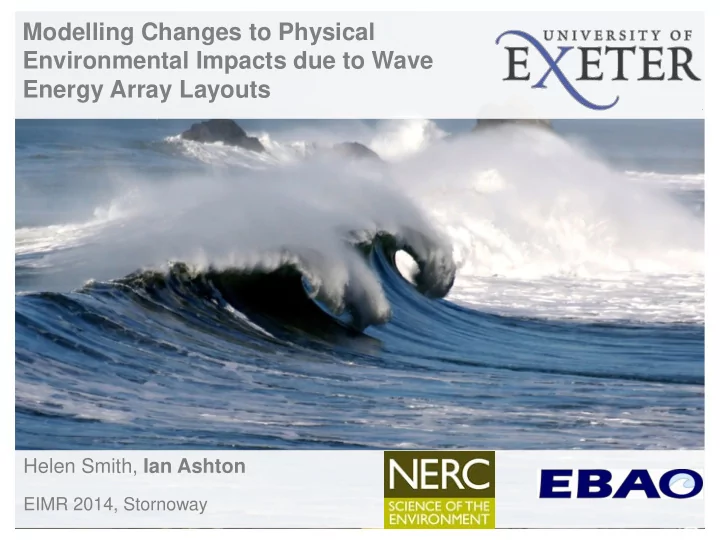

Modelling Changes to Physical Environmental Impacts due to Wave Energy Array Layouts Helen Smith, Ian Ashton EIMR 2014, Stornoway 20.05.2014
Overview 1. Context: The EBAO project 2. Theoretical modelling study 3. Case study for EMEC 4. Conclusions and future work Slide 2
EBAO “Optimising Array Form for Energy Extraction and Environmental Benefit” Scenario A: Constrained channel Tidal Scenario B: Sea area between Tidal mainland and island Scenario C: Inshore site Wave, Tidal Scenario D: Offshore site Offshore wind Slide 3
Theoretical model • 3 array scenarios • Grid: - Parallel depth contours - Real bathymetry (Orkney) • Deepest device located at 60m depth • 2 sea states – average and large • 5 wind scenarios • All modelling using SWAN spectral wave model Slide 4
Theoretical model – Scenario1 Slide 5
Theoretical model – Scenario 2 Slide 6
Theoretical model – Scenario 3 Slide 7
Theoretical model Wind scenarios Following: 5ms -1 , 10ms -1 , 20ms -1 Opposing: 10ms -1 Cross: 10ms -1 Slide 8
Theoretical model • SWAN spectral wave model • Devices represented as 50m partially transmitting barriers • Frequency-dependent energy absorption TrCoeff = H sT /H sI • Limitations of SWAN? Slide 9
Theoretical model Output 1000m 200m 10000m 5000m Shore Centre Slide 10
Theoretical model - results Sea state 1, no wind Slide 11
Theoretical model - summary • Increasing the number of devices increases the impact • Clusters of devices with corridors lessen impact closer to devices, but this becomes negligible by the shoreline • Impact decreases with increasing following or cross wind • Impact increases with opposing wind • Impact increases at shoreline for steeper seabed • Impact slightly higher for larger sea state Slide 12
EMEC case study 60 • Run over full year (2005) 59.6 • Input data from EMEC hindcast 59.2 • Same 3 scenarios 58.8 modelled • Output at three 58.4 ~10m depth locations 58 -4 -3.6 -3.2 -2.8 -2.4 -2 Slide 13
EMEC case study Location 1 Slide 14
EMEC case study Sea state corresponding to ‘small’ sea state, 20/3/05 15:00: H s = 1.56m, T m = 5.3s, D = 275° Slide 15
EMEC case study Sea state corresponding to ‘small’ sea state, 20/3/05 15:00: H s = 1.56m, T m = 5.3s, D = 275° Slide 16
EMEC case study Sea state corresponding to ‘small’ sea state, 20/3/05 15:00: H s = 1.56m, T m = 5.3s, D = 275° Slide 17
Conclusions • Array layout is important for near-field effects, less so for the far-field • Local wind and wave conditions more influential on the scale of the impact • Next stage is to examine how these impacts affect wider physical and ecological scenarios • Further work ongoing to develop the capability of spectral wave models to prediction such impacts – need validation! Slide 18
Thank you! h.c.m.smith@exeter.ac.uk i.g.c.ashton@exeter.ac.uk Slide 19
Recommend
More recommend